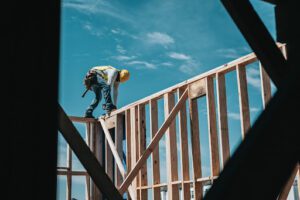Superintendents, Safety & Project Managers All Need Jobsite Daily Log Report Data
Keeping commercial worksites safe and secure requires access control and attendance records. If you don’t know who is or was on your site, you cannot assure safety and security, measure project progress, collaborate well, or manage risks. There are some of the reasons why you need to create a jobsite daily log report.

A wide variety of people arrive at jobsites: Employees, Subcontractors, Vendors, Visitors, Customers, Inspectors, etc. Not all will volunteer information. And not all will speak English. Or write legibly. Superintendents must be ready for anybody.
Today, most people can be expected to have a smartphone. But not all. And their phone may not be working. Or your firm may be required to compensate workers for personal phone use, and so will want to discourage phone use. Employees and subcontractors should be prepared for worksite requirements during onboarding, but not visitors, vendors and others.
When anything goes wrong at a worksite, the first thing managers ask is “who was there?”. You may call your process check-in, sign-in, clock-in, tag-in, roll call, or who knows what. But collecting basic jobsite data – like attendance – must be done everyday as part of your standard field operations practices. The jobsite daily log report is essential to jobsite control and risk management.
Supervisors Desperately Need Productivity Software
There is a huge shortage of experienced commercial worksite management supervisors compared to industry demand. And not only in construction but all hard-hat industries.
Here are just some of a Superintendent’s responsibilities. As anyone can see, it’s often way too much for one person. Superintendents need years of experience in the field to learn the ropes:
- Leading and directing the construction crews and their work on site.
- Securing access to the site and protecting assets such as tools and equipment.
- Scheduling and coordinating subcontractors, consultants, inspectors, and vendors.
- Monitoring the work for quality and compliance.
- Enforcing safety and health protections..
- Request and procure construction equipment.
- Estimate effort and costs and help manage budgets.
- Supervise staff and develop worker skills
- Monitor and report on project progress.
- Plan inspections, permits, remediation
- Tool and equipment tracking & maintenance.
- Material inventory, orders, delivery, quality.
- Incident and emergency handling.
These responsibilities may vary based on each project. On smaller projects, Superintendents may need to manage multiple jobsites. On bigger projects, some of these duties will go to a dedicated security manager, safety coordinator, field engineer, project manager or cost analyst. And today, even in offices, hybrid work patterns make receptionists a luxury most firms cannot afford.
Old school paper-based methods, or reliance on memory, cannot increase productivity enough to make up for the shortage of experienced Superintendents. They need assistance from modern software and, eventually, other technologies such as robotics, drones, AR/VR and AI.
Safety Managers Need Productivity Software Too
A construction Safety Manager is responsible for ensuring that all workers on a construction site follow safety protocols to minimize the risk of injuries or accidents. They work closely with project owners and contractors to develop safety plans and jobsite protocols to build a “culture” of safety.
The following are some of the responsibilities of a Construction Safety Manager to be performed in coordination with jobsite Superintendents:
- Are workers taking proper safety precautions and executing the project’s safety plans?
- Inspecting workplaces for unsafe conditions and risks
- Audits and inspections to ensure the personnel, equipment, and materials are in compliance with government safety regulations
- Provide procedures that comply with construction standards and safety regulations and promote safe operating practices
- Develop an Emergency Action Plan and serve as management’s primary contact for site injury and incident notification, investigation, and case management
- Ensure that everyone involved in any given project complies with company-wide standards as well as local and state laws such as health codes, building codes, plumbing codes, or electrical codes
here are a variety of certifications for Construction safety managers including: Construction Health & Safety Technician (CHST), CSCS or CCDS cards, 10-Hour or 30-Hour OSHA Construction Outreach Training Program (COTP), Hazardous Material Management (HAZWOPER), and FIRST AID/CPR certification.
Experienced Safety Managers may be in somewhat more supply than Superintendents or Project Managers. But to improve Construction safety industry-wide, safety must be built into the builder’s business culture. Cultural change means safe construction practices and learning must be baked into a firm’s mission, values and every activity onsite.
Again, old school paper-based methods, or reliance on memory, cannot increase productivity enough to make up for the shortage of Safety Managers who understand cultural change. They need assistance from modern software.
Project Managers Live On Jobsite Data
A construction Project Manager is often responsible for overseeing the entire construction process, from planning to completion. They work closely with architects, engineers, and field operations to ensure that the project is completed on time, within budget, and to the required quality standards.
The following are just some of the responsibilities of a construction Project Manager:
- Develop and maintain a detailed digital project plan that outlines the scope, tasks, resources, budget, and timeline of the project
- Coordinate with architects and engineers on plans and specifications
- They must also be knowledgeable about construction methods, materials, and safety regulations
- Project managers will sometimes select general contractors and usually subcontractors as well.
- Collaborate with field teams to ensure that all work is completed in compliance with building codes, safety regulations, and other legal requirements
- Monitoring the project budget, of course
- Communicating with stakeholders, including clients, contractors, and suppliers, to ensure that everyone is aware of the project’s progress and issues
- Preparing progress reports and other documentation to keep stakeholders informed of the project’s status
Most of a Project Manager’s work is performed in software with data. As with all jobsite professionals, Construction Project Managers must have excellent communication, leadership, and problem-solving skills. Such a broad range of required skills makes construction Project Managers almost as hard to find as experienced Superintendents. Getting them the data they need in a timely fashion is critical to raising productivity.
The Back Office Needs Jobsite Daily Log Reports Too
When all jobsites create a jobsite daily log report, workflows between the field and HQ all work better. Construction cost and time managers require the same basic attendance data that Project Managers do. HR is usually part of worker onboarding, and almost always tasked with incident handling. HR is also often tasked with payroll duties, and therefore need to sort out hourly wage disputes. And if insurance claims and risk management data from the field isn’t digital, HQ workers have no choice but harass field operations for the required data.
Paper, Field Data Entry and Human Memory are Poor Solutions
Safe Site Check In’s jobsite management app and worksite daily log reports are designed to raise the productivity of everyone on your entire field operations team, and the HQ teams that rely on field data.
Construction Superintendents want to be builders, not bureaucrats with paper forms, or gatekeepers watching workers scribble. Nor do they want to be data entry clerks typing names and times into an online form.
Safety Managers concerned with cultural change in any industry need to monitor the site, train and develop best safety practices. Participation in the field, not filling in forms, is what they need to be more productive.
Project Managers don’t want to chase down basic progress data, harass Superintendents, or key in data that’s already digital.
And HR, risk, cost and compliance managers don’t want to wade through paper files or pull field ops away from their jobs to get the data they need.

David Brian Ward is a CEO and Founder of Safe Site Check In LLC, a digital jobsite management platform launched in 2020 for the Construction industry. With over 40 years of experience in the technology industry, having launched and grown several successful companies. Mr. Ward is a now a SaaS entrepreneur and innovation leader in the Construction industry.



